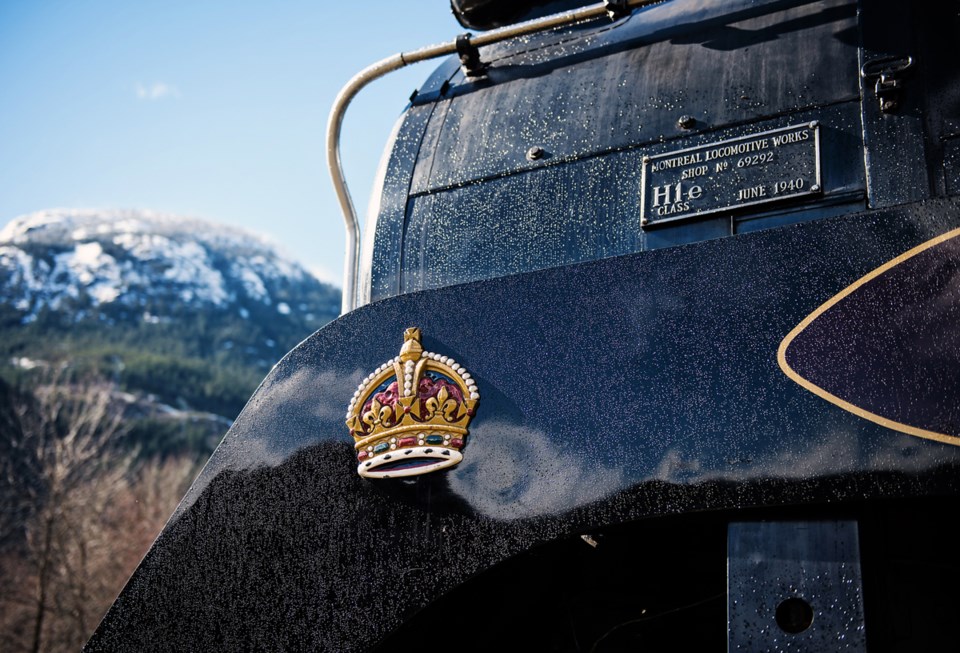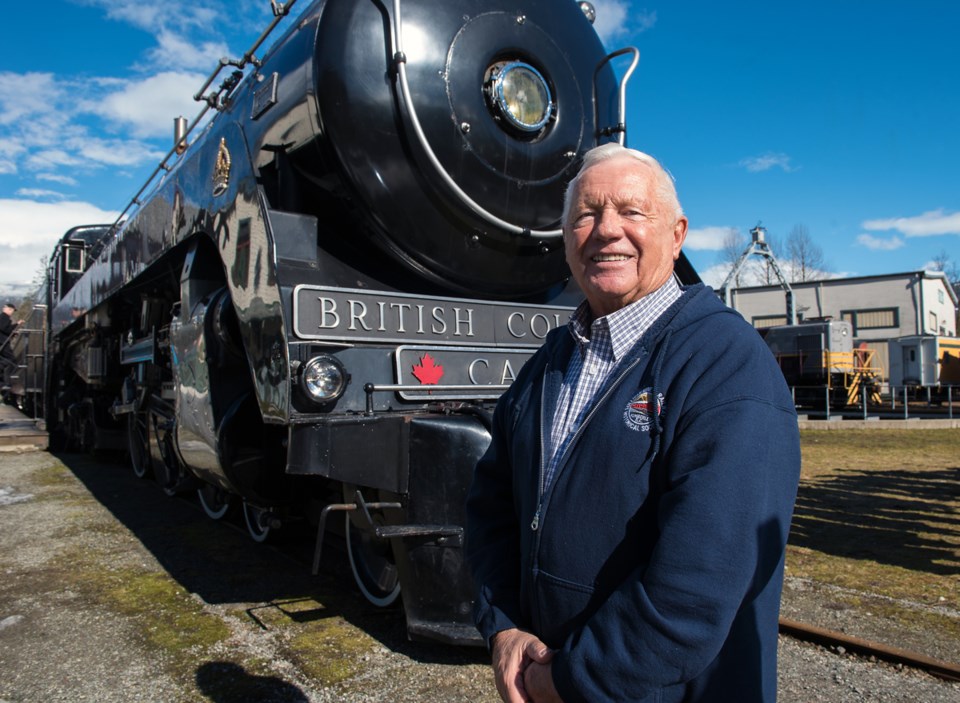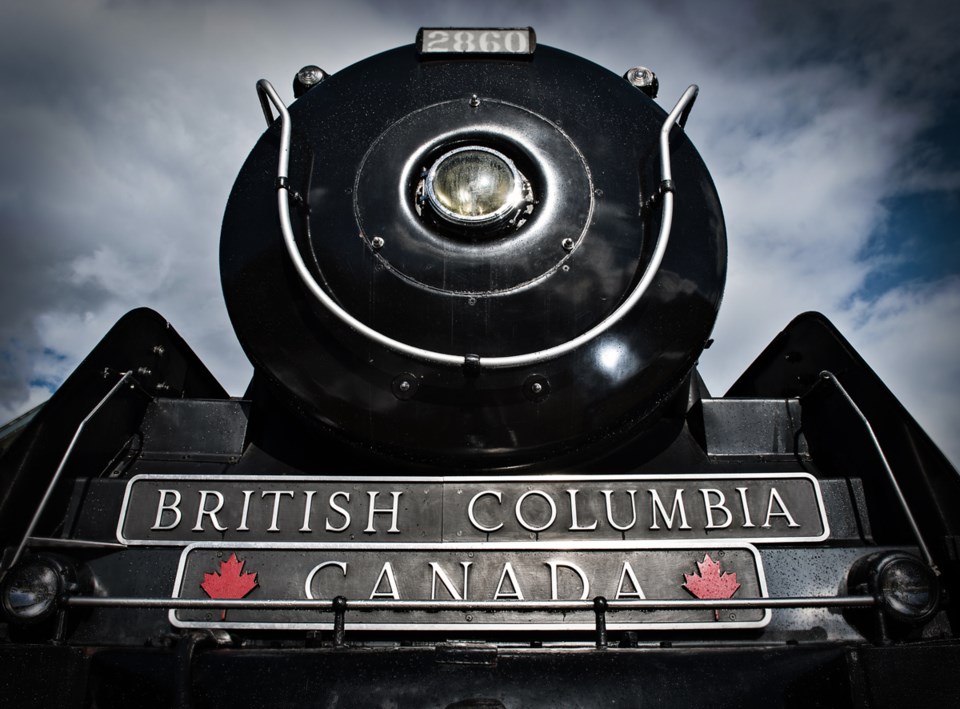The Royal Hudson steam locomotive 2860 departed Vancouver for Los Angeles 40 years ago to the day this past weekend. The engine left B.C. Hydro’s Kitsilano yard, hauling seven cars with B.C. artifacts, replicas of the crown jewels along with life-sized waxworks of Queen Elizabeth II, Prince Philip and Prince Charles. It clackity-clacked along the Arbutus Corridor to Marpole to New Westminster, through White Rock and across the border into Blaine, Wash.
Roy Shields, a reporter for the Province, rode the train for the first day of the three-week journey and wrote a column about it in the newspaper’s entertainment section.
“Half of Vancouver seemed to be lined up along the tracks,” he wrote in the article, published March 21, 1977. “People waved from their balconies, their bedroom windows, their cars. Fathers held kids on their shoulders, pointing. Everyone appeared to have a camera and was clicking away.”

The train stopped in New West to pick up additional crewmen as well as a stowaway — a 24-year-old by the name of Rick Riek, described as a “construction worker, in jeans, with a black hat sprouting a yellow feather.” He was booted off on the south shore of the Fraser River.
The legendary trip may seem like ancient history to a young city, but the stories of the Royal Hudson’s Jubilee Tour were alive and well at Saturday’s 40th anniversary celebration at the West Coast Railway Heritage Park in Squamish. The day had the feel of a high school reunion.
Vrlak Robinson Advertising, run by Steve Vrlak and Red Robinson, marketed the Jubilee Tour. Valerie Vrlak, Steve’s wife, was in charge of media relations and remembered how enthusiastic Grace McCarthy, the Social Credit government’s minister of travel, was about the idea of a train tour.
“It was a great plan,” said Vrlak. “She thought we should have better tourism going for this province so she thought, ‘Well, let’s just take the province to California.’”
Most people helping out with the tour traveled with the train all the way to L.A. and back by car or bus, following its route and sleeping in motels. Sleeping cars were added for 2860’s next two tours, the 1978 journey across Canada and the 1979 tour to northern B.C.

When it was Vrlak’s turn to speak at the podium, she pointed to John Plul in the audience and told a story about how Plul, who took part in the trip as deputy minister of travel, dealt with seal hunt protesters who held up the train in San Francisco. “John said, ‘We’re from British Columbia! They’re 5,000 miles from where we live!’” recalled Vrlak.

Plul, when asked about the incident, remembered then city mayor George Moscone intervening. “And, because of that, we got into the New York Times. It was publicity like you wouldn’t believe,” said the former vice president of CKNW radio.
Vrlak, who now lives in Yaletown, had fond memories of people such as Bob Swanson who invented the first five and six-chime locomotive horns on his whistle farm on Vancouver Island (he also built the Heritage Horns that were on the roof of Vancouver’s old B.C. Hydro Building that played the first four chords of “O Canada” at noon every day). Swanson, who was said to quote Robert Service poems at every opportunity, was one of the major forces behind the restoration of the Royal Hudson 2860, raiding old steam engines across North America for parts.
Steam trains littered scrap yards as the engines were replaced by streamlined diesels in 1956. By 1960, Canadian Pacific Railway’s records listed the Hudsons as all scrapped. The exception was the 2850, on display at Quebec’s Canadian Railway Museum (it had carried King George VI and then-Princess Elizabeth to Vancouver from Quebec City in 1939 and the king was so impressed by the engine, he granted CPR permission to use the royal family crown on the Hudson’s running boards and the royal designation).

A group of rail buffs from Vancouver found the 2860 sitting in a scrap yard in Winnipeg during the early 1960s, five years after dutifully moving people between Vancouver and Revelstoke. With help from the City of Vancouver, the group had it towed and cosmetically restored, but, by 1970, it was destined for scrap again when the Vancouver Railway Museum Association, created by the same rail buffs that rescued the 2860, couldn’t find a place to store it.
The provincial government bought the train in 1974 and, after extensive restoration by Swanson’s team and the staff at the CPR Drake Street roundhouse (now the Roundhouse Community Centre), it was used as an excursion train from North Vancouver to Squamish. That stint lasted 25 years until the engine’s boiler went in 1999. In 2002, it was loaned to the District of Squamish for display at the rail park and, by donation, the WCRA steamed up the engine in 2006. Since then, the train has appeared at the 2010 Vancouver Winter Olympics and the opening of the downtown Louis Vuitton store that same year.

The engine still needs work; the driving wheels and main bearings need to be rebuilt. It’s an ongoing project, well worth the effort say those involved. According to the WCRA website: “Seeing a mainline steam locomotive in operation these days is a very rare and special thing.”
That was the case even 40 years ago. In Shield’s article, he wrote about the sight of the 2860 causing a minor crash between a camper and a VW van. “The driver of a camper ahead of him was so startled to see a steam engine on the tracks that he braked to a sudden stop in the middle of the road.”



